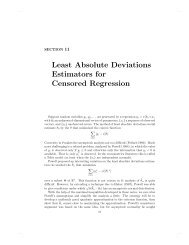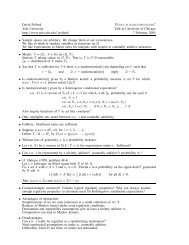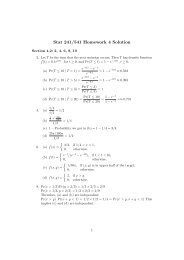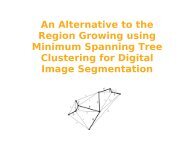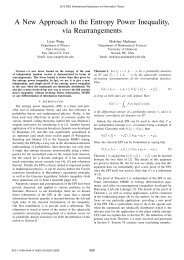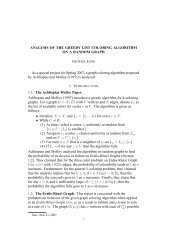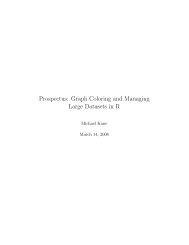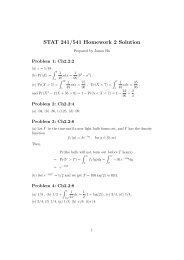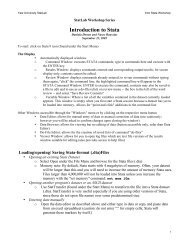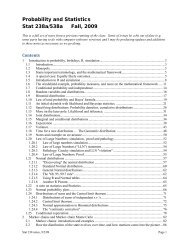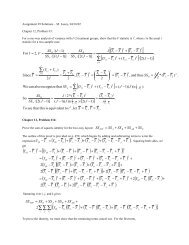Detecting and Estimating Sparse Mixtures - Welcome to the ...
Detecting and Estimating Sparse Mixtures - Welcome to the ...
Detecting and Estimating Sparse Mixtures - Welcome to the ...
Create successful ePaper yourself
Turn your PDF publications into a flip-book with our unique Google optimized e-Paper software.
<strong>Detecting</strong> <strong>and</strong> <strong>Estimating</strong> <strong>Sparse</strong> <strong>Mixtures</strong><br />
Jiashun Jin<br />
Statistics Department<br />
Stanford University<br />
Abstract<br />
<strong>Sparse</strong> Mixture Models have important applications in many areas, such as Signal <strong>and</strong><br />
Image Processing, Genomics, Covert Communication, etc. In my talk, I will consider <strong>the</strong><br />
problems of detecting <strong>and</strong> estimating sparse mixtuers.<br />
Detection Higher Criticism is a statistic inspired by a multiple comparisons concept<br />
mentioned in passing by Tukey (1976) (but as a term, Higher Criticism is invented by a<br />
German his<strong>to</strong>rian Johann Eichhorn (1787)). We are able <strong>to</strong> show that <strong>the</strong> resulting Higher<br />
Criticism statistic is effective at resolving a very subtle testing problem: testing whe<strong>the</strong>r n<br />
normal means are all zero versus <strong>the</strong> alternative that a small fraction is nonzero; <strong>the</strong> subtlety<br />
of this ‘sparse normal means’ testing problem can be seen from work of Ingster (1999) <strong>and</strong><br />
Jin(2002), who studied such problems in great detail. In <strong>the</strong>ir studies, <strong>the</strong>y identified an<br />
interesting range of cases where <strong>the</strong> small fraction of nonzero means is so small that <strong>the</strong><br />
alternative hypo<strong>the</strong>sis exhibits little noticeable effect on <strong>the</strong> distribution on <strong>the</strong> p-values<br />
ei<strong>the</strong>r for <strong>the</strong> bulk of <strong>the</strong> tests or for <strong>the</strong> few most highly significant tests. In this range,<br />
when <strong>the</strong> amplitude of nonzero means is calibrated with <strong>the</strong> fraction of nonzero means, <strong>the</strong><br />
likelihood ratio test for a precisely-specified alternative would still succeed in separating<br />
<strong>the</strong> two hypo<strong>the</strong>ses. We show that <strong>the</strong> higher criticism is successful throughout <strong>the</strong> same<br />
region of amplitude vs. sparsity where <strong>the</strong> likelihood ratio test would succeed. Since it<br />
does not require a specification of <strong>the</strong> alternative, this shows that Higher Criticism is in a<br />
sense optimally adaptive <strong>to</strong> unknown sparsity <strong>and</strong> size of <strong>the</strong> non-null effects. While our<br />
<strong>the</strong>oretical work is largely asymp<strong>to</strong>tic, we provide simulations in finite samples. We also<br />
show Higher Criticism works very well over a range of non-Gaussian cases.<br />
Estimation False Discovery Rate (FDR) control is a recent innovation in multiple hypo<strong>the</strong>sis<br />
testing, in which one seeks <strong>to</strong> ensure that at most a certain fraction of <strong>the</strong> rejected<br />
null hypo<strong>the</strong>ses correspond <strong>to</strong> false rejections (i.e. false discoveries). The FDR principle<br />
also can be used in highly multivariate estimation problems, where it has recently been<br />
shown <strong>to</strong> provide an asymp<strong>to</strong>tically minimax solution <strong>to</strong> <strong>the</strong> problem of estimating a sparse<br />
mean vec<strong>to</strong>r in <strong>the</strong> presence of Gaussian white noise. In effect, FDR provides an effective<br />
method of setting a threshold for separating signal from noise when <strong>the</strong> signal is sparse <strong>and</strong><br />
<strong>the</strong> noise is Gaussian.<br />
In this talk we consider <strong>the</strong> application of FDR thresholding <strong>to</strong> non-Gaussian settings,<br />
in hopes of learning whe<strong>the</strong>r <strong>the</strong> good asymp<strong>to</strong>tic properties of FDR thresholding as an<br />
estimation <strong>to</strong>ol hold more broadly than just at <strong>the</strong> st<strong>and</strong>ard Gaussian model. We study<br />
sparse exponential model <strong>and</strong> sparse Poisson model, which are important models for non-<br />
Gaussian data, <strong>and</strong> have applications in many areas as well, such as Astronomy <strong>and</strong> Positron<br />
Emission Tomography (PET) etc. We show that <strong>the</strong> FDR principle also provide an asymp<strong>to</strong>tically<br />
minimax solution <strong>to</strong> <strong>the</strong> problem of estimating a sparse mean vec<strong>to</strong>r even in <strong>the</strong><br />
presence of exponential/Poisson noise, <strong>and</strong> in effect FDR provides an effective method of<br />
setting a threshold for separating signal from noise when <strong>the</strong> signal is sparse <strong>and</strong> <strong>the</strong> noise<br />
is exponential/Poisson.<br />
We compare our results with work in <strong>the</strong> Gaussian setting by Abramovich, Benjamini,<br />
Donoho, Johns<strong>to</strong>ne (2000).<br />
Joint work with David L. Donoho.<br />
References<br />
[1] The Antiquity of <strong>the</strong> Books of Moses, http://www.heraldmag.org/books<strong>to</strong>re/booklet antiquity.htm.<br />
[2] Jin, J. Detection Boundary for <strong>Sparse</strong> <strong>Mixtures</strong>, in preparation.<br />
[3] Donoho, D. <strong>and</strong> Jin, J. (2002). Higher Criticism for <strong>Detecting</strong> <strong>Sparse</strong> Heterogeneous <strong>Mixtures</strong>.<br />
Technical Report , Statistics Department, Stanford University.<br />
1
[4] Abramovich, F. <strong>and</strong> Benjamini, Y. <strong>and</strong> Donoho, D. <strong>and</strong> Johns<strong>to</strong>ne, I. (2000). Adapting<br />
<strong>to</strong> Unkown Sparsity by Controlling <strong>the</strong> False Discovery Rate, Technical Report , Statistics<br />
Department, Stanford University.<br />
[5] Donoho, D. <strong>and</strong> Jin, J. Asymp<strong>to</strong>tic Minimaxity of False Discovery Rate for <strong>Sparse</strong> Exponential<br />
Data, in preparation.<br />
[6] Donoho, D. <strong>and</strong> Jin, J. Asymp<strong>to</strong>tic Minimaxity of False Discovery Rate Thresholding for<br />
<strong>Sparse</strong> Poisson Data, in preparation.<br />
2



